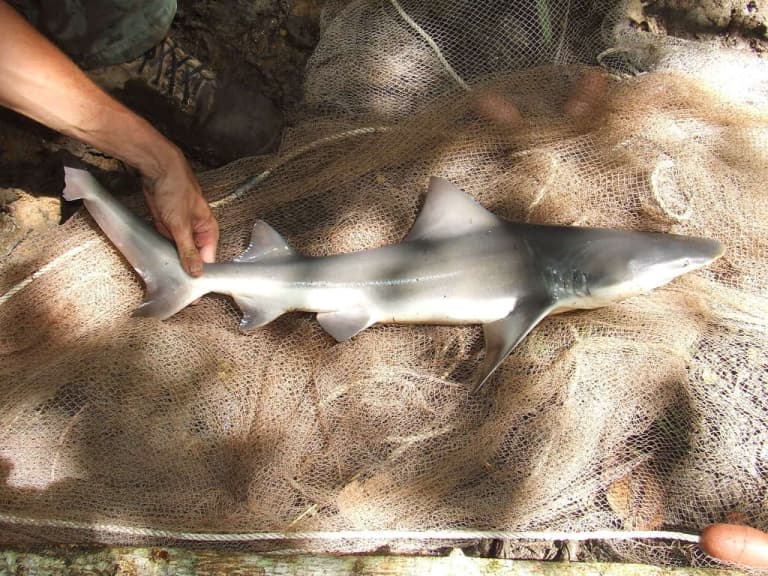Speartooth Shark Profile
Some animals don’t really look the part. The drab plainness of an African Grey parrot belies its incredible intelligence and ability to shout profanities at the wrong moment.
If you were to look at a tuatara, you’d have no idea that it hasn’t been related to an iguana in over 250 million years, and if you were lucky enough to see a Glyphis, or “speartooth” shark you’d probably never know quite how lucky you were.
The speartooth shark is a rare species of river shark, that inhabits marine waters and rivers in northern Australia and New Guinea.

Speartooth Shark Facts Overview
| Habitat: | Murky rivers and estuaries |
| Location: | Northern Australia, New Guinea |
| Lifespan: | Unknown |
| Size: | Up to 2.6 m (8.5 ft) |
| Weight: | Not reported |
| Colour: | Grey |
| Diet: | Bony fish, rays |
| Predators: | Likely none |
| Top Speed: | Unknown |
| No. of Species: | 1 |
| Conservation Status: | Vulnerable (IUCN) and Critically Endangered (SPRAT) |
There’s not a huge amount known about this shark, on account of it hardly ever being seen. It’s certainly an outlier in almost every category.
Not as powerful as many of its family, it also doesn’t spend as much time in the ocean, instead choosing to peruse the diverse selection of fish, rays, and crustaceans in the tidal estuaries and rivers.
It’s incredibly rare, even for a shark, and stands a strong chance of becoming rarer, as commercial fishing and pollution threaten its populations.
Interesting Speartooth Shark Facts
1. They’re requiem sharks!
Every family has its runts, and while the requiem sharks are typically some of the best-looking sharks out there, this one isn’t typical at all.
First of all, it has a lot less of the power that’s common in the family, it’s more of a skinny shark rather than a slender one, and its tiny eyes sit on a relatively stunted face. This is, by all appearances, a very average-looking shark; there’s nothing exactly wrong with it, but it doesn’t have the ‘pop’ of some of its relatives.
And this is, more than likely, because it lives in almost total darkness. 1
2. They’re one of the few river sharks
The tiny eyes that knock points off its high street rating are a product of the murkiness of its habitat. Unlike almost every other shark, these live in the river.
River estuaries are a mess of churned-up sediment and mud and all things swept downstream, so the water is impossible to see through.
As a result, many animals’ eyes atrophy entirely if they spend their entire lives in the river, but this species of shark still has some kind of eyesight.
The lower muscle mass may be also a result of the nature of moving water – something that can take a substantial effort off swimming. Tracking suggests they use the tidal waters to their advantage; moving downstream with the outgoing tide and upstream as it floods back in.
But it’s the murkiness of its water that makes this shark so hard to understand.

3. They’re incredibly rare
Juveniles are thought to inhabit the relative safety of mangrove forests, and despite the species having been described by Germans in the 1800s, only three adults have ever been recorded.
These came very recently, in 2014, and gave the only data we have on what mature individuals do and look like.
For such a large, apex predator, this is very unusual. Not only are they hard to see in such muddy waters, but they also appear to be quite rare, and so finding examples of them to learn about their habits and biology is a challenge.
As a result, we know almost nothing about them! 2
4. They probably eat stingrays
From the few that have been caught, it looks like they get into mouthy battles with stingrays. This was evidenced by a barb from one of them, embedded in the jaw of the shark.
Lots of bony fish spines were also found in the same place, suggesting these two foodstuffs are common for the shark.
Catfishes are found in stomachs, so are freshwater prawns, so it clearly isn’t fussy about the type of food it eats.
5. They’re probably tough
The youngsters inhabit fresh, fast-moving waters, which are so cloudy that at a meter down it’s already total darkness. They must hunt using electroreception, and somehow they also find one another to mate.
But what’s particularly interesting about their habitat is that it varies from almost completely seawater to almost completely freshwater, suggesting that they have and incredible tolerance to a range of salinities.
6. They’re threatened by pollution and fishing
The other thing we can be fairly sure of is that this is a shark in trouble.
Commercial and small-scale fishing pulls up juveniles in the New Guinea part of their range, and it’s kept for eating. In Australia, it’s dragged up by mistake by commercial gillnets, line and pot fisheries.
Dams, weirs and road crossings might play a role in this species’ struggle, but it’s uncertain to which degree.
River pollutants from mining operations in Papua New Guinea appear to be a threat in its Northernmost range. 3
Speartooth Shark Fact-File Summary
Scientific Classification
| Kingdom: | Animalia |
| Phylum: | Chordata |
| Class: | Chondrichthyes |
| Order: | Carcharhiniformes |
| Family: | Carcharhinidae |
| Genus: | Glyphis |
| Species: | Glyphis Glyphis |
Fact Sources & References
- William T. White (2015), “Rediscovery of the Threatened River Sharks, Glyphis garricki and G. glyphis, in Papua New Guinea”, NIH.
- Animal Planet (2015), “Fan Favorite: Rare Glyphis Shark Filmed | River Monsters”, YouTube.
- “Speartooth Shark”, IUCN Red List.
